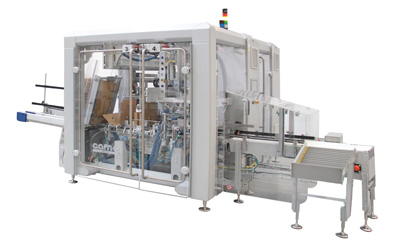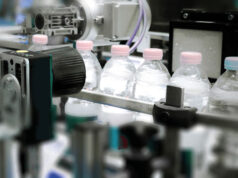 Realizzato da Cama Group per una multinazionale del food, l’impianto per l’imballaggio secondario e terziario di stand up pouch in varie configurazioni pronte per lo scaffale della GDO risponde in modo puntuale alle esigenze di produttività elevata, ergonomia, cambio formato rapido e flessibile
Realizzato da Cama Group per una multinazionale del food, l’impianto per l’imballaggio secondario e terziario di stand up pouch in varie configurazioni pronte per lo scaffale della GDO risponde in modo puntuale alle esigenze di produttività elevata, ergonomia, cambio formato rapido e flessibile
Confezionare pouch in diversi formati shelf-ready
Negli ultimi tempi, diversi fattori a livello globale hanno modificato abitudini e stili di vita di miliardi di persone. Come altri settori, il comparto alimentare ha subito una rapida evoluzione, a seguito della crescita esponenziale dell’eCommerce, accelerata durante la pandemia, e dell’affermazione di nuovi modelli di marketing e consumo, con l’avvento di campagne, offerte e linee di prodotto diversificate, in tutti i canali distributivi, GDO in primis.
In questo scenario, la fornitura di impianti di produzione e confezionamento ultra-flessibili, configurabili in modo rapido e semplice a seconda delle necessità è una condizione imprescindibile per la competitività. 
Cama Group, in prima linea nell’affrontare la domanda di maggiore efficienza, ha fornito di recente a una multinazionale del comparto food un impianto di confezionamento secondario e terziario, in grado di coniugare ritmi produttivi elevati con un’estrema flessibilità nel cambio formato.
Specifiche di un progetto made in Italy
L’impianto fornito da Cama confeziona un prodotto di uso quotidiano per l’alimentazione dei bambini contenuto in stand up pouch con tappo apri e chiudi: una scelta vantaggiosa, quella del formato Doypack richiudibile e pronto per un consumo “on the go”, in termini di praticità, dosaggio agevole, conservazione e trasportabilità.
Ma per rispondere alle esigenze distributive della GDO, era però necessario ottimizzare il confezionamento con formati pronti per l’esposizione sul punto vendita.
Cama ha dunque proposto una soluzione studiata per confezionare gli stand up pouch in astucci SRP (Shelf Ready Packaging) realizzati a partire dal fustellato steso, che vengono quindi imballati in casse wrap around adatte alla gestione nei supermercati.
L’intervento di Cama ha, inoltre, permesso di sostituire i due impianti produttivi preesistenti – adibiti, rispettivamente, alla creazione di astucci da preincollato e di confezioni wrap-around da cartone steso – con un’unica macchina in grado di eseguire tutti gli step del confezionamento a fine linea.
Dal pouch all’astuccio SRP
I pouch, controllati e ordinati, vengono inseriti negli astucci Shelf Ready Packaging in fustellato steso di cartone compatto (prima si usava un cartone preincollato) per astucci multipack da quattro pouch da 100 g ciascuno o microonda per altri formati (con chiusura tramite colla a caldo).
Questa è la grammatura impostata attualmente per i pouch ma sono possibili diversi formati (da 85, 90, 100, 128, 130 e 180 g) a seconda dei programmi di produzione. Si potranno inserire formati più importanti come quello da 500 g. Velocità da 30 a 72 imballi SRP/minuto (formato 4×100 g).
Gli astucci Shelf Ready Packaging (da quattro pouch) vengono poi raggruppati e inseriti in casse wrap around di cartone ondulato da fustellato steso (chiusura tramite colla a caldo). Ogni cassa wrap-around contiene tre astucci. Velocità da 10 a 20 casse/minuto.
FW746: più operazioni con una sola macchina
I diversi passaggi vengono realizzati da una sola macchina molto compatta: il modello FW746 di Cama Group, sviluppato a partire dalla macchina standard FW748, che consente di creare casse molto compatte (fino a un quarto di pallet, 400 x 300 mm) come richiesto dalla GDO.
Il modello FW746 può essere integrato nell’unità robotizzata monoblocco, creando così un sistema di confezionamento completo, dalla formazione fino al carico e alla chiusura delle scatole: il packaging primario, in entrata, esce imballato nella cassa pronta per la spedizione.
Materiali sostenibili
Ricordiamo infine che, in linea con la tendenza a minimizzare l’impiego di materiali plastici, gli impianti Cama utilizzano materiali a base cellulosica, quindi plastic free: un requisito molto apprezzato dall’azienda committente, particolarmente attenta agli aspetti di sostenibilità ambientale, che richiedeva la possibilità di impiegare materiali da imballaggio ecocompatibili.
www.camagroup.com
www.clevertech-group.com
Doypack for daily use with the flexible configurable packaging system
Cama Group has created for a food multinational a secondary and tertiary packaging line for stand-up pouches ready to the shop shelves that promptly meets high-speed production, ergonomics, fast and flexible format change requirements
Various factors have influenced the behaviour of billions of people. The production system has evolved to accommodate evolving consumer demands. The food industry has seen a rapid evolution in market request, with large-scale distribution, eCommerce, Covid, and increasingly diverse offers making very flexible packaging methods vital and adaptable to changing needs.
In Cama Group they have experienced these developments with a secondary packaging line created for a food multinational that required a flexible, ergonomic, high-speed production and fast format change system. To match market demands, you must be smart.
The plant’s customer is a firm that is extremely concerned about environmental sustainability. It uses ecologically friendly materials in its goods, and the systems may be customized to modify the formats according to needs using this made in Italy solution.
The plant must pack a daily use product for feeding children in a pouch with an open and close cover that can be maintained in the mother’s bag or backpack to be used and stored during the day.
Using a Pouch with a cap as a container in its Shelf Ready Packaging is critical for the benefits of practicality, product dosing, storage, and transportation that this format provides. Technically, it entails packaging doypacks (stand-up pouches) into flat blank boxes. Following that, the same cases must be encased in a wraparound case. As a result, a single packing machine replaces two pre-existing production plants: one for pre-glued boxes and another for flat cardboard wrap-around packs.
The pouch’s trip to the shop shelves
After the Doypacks (stand-up pouches) have been filled in the filler area, they are placed in the packaging flow and their journey to the supermarket shelves begins. Cama’s system, which he designed and built, begins at the filler’s exit with the orderer, who determines the correct flow of the products and their orientation during the transport path:
• Products: doypacks with caps (stand-up pouches ranging in weight from 85 to 180 g) advance from the filler in a constant flux, lying on the long side facing the march; they are picked and packaged in SRP (Shelf Ready Packaging) boxes.
• Sorting: the pouches are initially arranged in two rows to feed the two machines for secondary packaging; once the third machine on the line is added, they will move to three rows.
• Along the way: the products are weighed, labeled, checked with an X-ray system for the presence of contaminants, and then sorted with the divider, which orders the products to the packaging lines for the creation of both types of format.
The first operation is to transfer the Pouch to the SRP case
The pouches are checked and sorted before being inserted into Shelf Ready Packaging boxes made from flat blanks (previously a pre-glued cardboard was used) for multipack boxes of four pouches of 100 g each or microwave for other formats (with hot glue closure).
This is the current weight for the pouches, but different sizes (85, 90, 100, 128, 130, and 180 grams) are possible depending on the production programs. It will be possible to include larger formats, such as the 500 gram one. Speed ranges from 30 to 72 SRP packages per minute (4×100 gram format).
SRP tertiary packaging is the second operation
The Shelf Ready Packaging boxes (four pouches) are grouped and placed in corrugated cardboard wraparound boxes made from flat blanks (closed with hot glue). There are three cases in each wrap case. Speed ranges from 10 to 20 cases per minute.
Cama FW746 model is versatile, allowing it to perform multiple tasks with a single machine
The FW746 model by Cama Group (derived from the FW748, standard machine) can create crates with dimensions up to a quarter of a pallet (400 X 300 mm) for products that require reduced packaging due to the demands of the large-scale retail trade.
The FW746 model can be integrated into a monobloc robotic unit to create a complete packaging system with box formation, loading, and closing: the product enters with primary packaging, and the box exits ready for shipment.
Cama plants make use of environmentally friendly materials derived from paper. Plastic materials have been phased out of the market. Cama has an advantage because it uses cardboard and its secondary packaging solutions are free of plastic.
www.camagroup.com
www.clevertech-group.com









